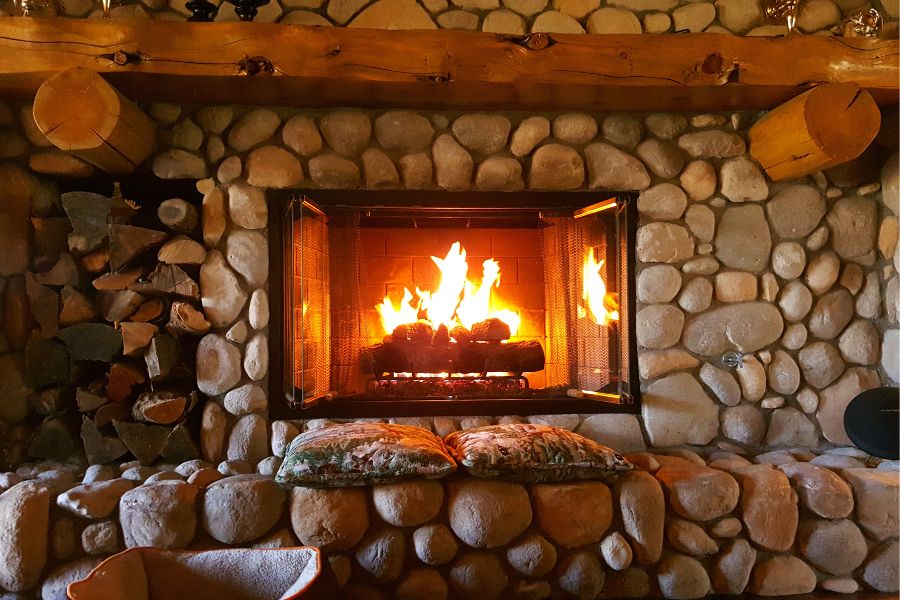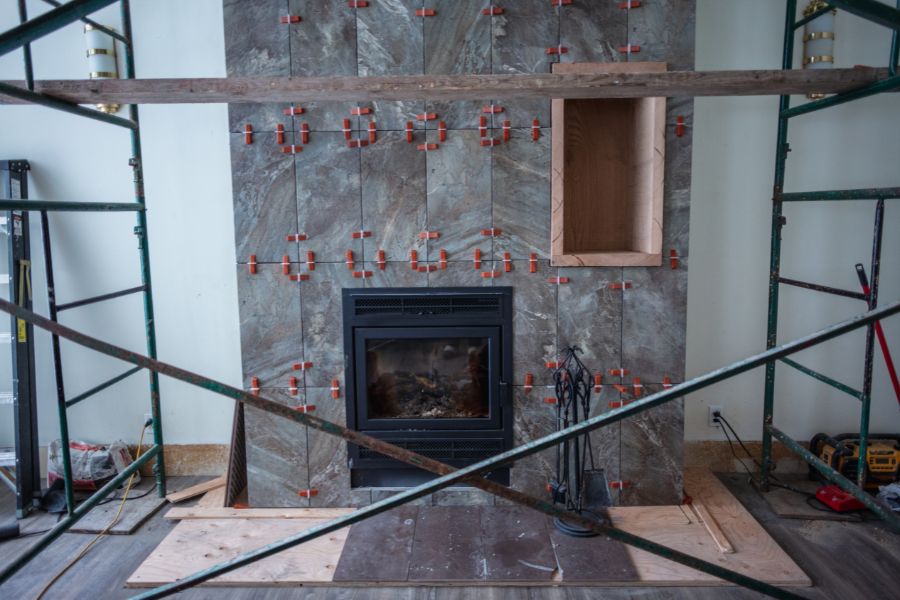Learn How to Take Out Fireplace Insert
Removing a fireplace insert, be it a wood-burning fireplace insert, gas fireplace insert, or a wood stove fireplace insert, can be necessary for various reasons. Whether updating your home’s aesthetic, performing essential maintenance, or replacing an outdated unit, understanding how to take out fireplace insert is crucial for safety and efficiency. This guide will focus on removing different inserts, including the classic wood-burning fireplace insert, the convenient gas insert, and the traditional wood-burning stove insert. Each type requires specific considerations to ensure a safe and effective removal.
If you would like to learn more about climate change, solar generators, or the sun’s power, check out these articles.
Preparing For the Removal
Gather Necessary Tools and Safety Equipment
The first step in removing any fireplace insert, whether a wood-burning fireplace or gas insert, is to ensure you have all the necessary tools and safety equipment. This includes screwdrivers, wrenches, pliers, pry bars, hammers, protective gloves, and safety goggles. A dust mask is also essential, especially when dealing with older inserts like a wood-burning stove or fireplace insert, which may have accumulated dust and soot over the years.
Clearing the Surrounding Area
Before you remove your insert, creating a safe working space is essential. This means removing furniture, rugs, or other items near the fireplace. If you’re dealing with a wood-burning insert or a wood stove fireplace insert, ensure ample space to work without the risk of igniting nearby items. Place drop cloths or plastic sheets to protect the flooring from debris, dust, and potential scratches, a common concern when dealing with heavier units like a wood-burning fireplace or a gas fireplace insert.
Disconnecting Necessary Utilities
Shut Off Energy Sources
For safety purposes, the first step in the removal process, especially when dealing with a gas insert or gas insert, is to turn off the energy source. This includes shutting off the gas supply for gas-powered units and unplugging electric inserts. Ensuring that all pilot lights are turned off for gas inserts is crucial. For wood-burning fireplace inserts, although there isn’t a direct energy source to shut off, ensure that the fireplace is completely relaxed and there are no smoldering embers.
Disconnecting Gas and Electrical Connections
After ensuring that the energy source is completely shut off, it’s time to disconnect the physical connections. Locate the shutoff valves and carefully disconnect the gas line, following the manufacturer’s instructions for a gas insert. Similarly, unplug any electric fireplace inserts from their power sources. When dealing with a wood-burning fireplace insert or a wood-burning stove, you may not have gas or electrical connections. Still, it’s essential to ensure that any connections to the chimney or flue are safely and adequately disconnected before proceeding with the removal.
Removing Trim and Surrounding Décor
Detach Trim and Decorative Elements
The first step in removing a fire insert, whether a wood stove insert, an electric fireplace insert, or a traditional wood fireplace, involves carefully detaching any trim or decorative elements. This includes mantels, surrounds, glass doors, or screens in the existing fireplace structure. It’s essential to use the appropriate tools, such as screwdrivers or pry bars, to carefully remove these components without causing damage. For an electric fireplace insert, be mindful of any electrical connections or wires that may be integrated with these decorative elements.
Handling the Glass Doors
If your fireplace insert, particularly a wood stove insert or a wood-burning fireplace insert, includes glass doors, handle them carefully. Glass doors are fragile and can also be heavy and unwieldy. Use appropriate support and care when removing them to prevent breakage and ensure safety, especially if the fireplace insert is heavy.
Chimney and Insert Detachment
Disconnecting from the Chimney
The next step involves detaching a wood-burning insert from the chimney components. This step is crucial for ensuring that the removal process doesn’t affect the structural integrity of the existing fireplace and chimney. Carefully disconnect any gas lines or flue pipes connected to the insert. This might require tools like wrenches or pipe cutters, especially if the connections are tight or have been in place for a long time.
Removing a Wood Stove or Wood Insert
Removing a wood stove or wood-burning insert from the existing fireplace involves additional considerations. Ensure all connections to the chimney or flue are properly and safely disconnected. For a wood stove, pay extra attention to the stovepipe and its connection to the chimney. If the wood stove or fireplace insert is heavy, plan for additional help or equipment like a dolly to safely move it.
Handling Electric Fireplace Inserts
Disc disconnect and manage any electrical wiring carefully when removing an electric insert. Ensure that all electrical connections are safely handled to prevent any risk of electric shock.
Cleaning and Maintenance Tips
After removing the fireplace insert, it’s an excellent opportunity to clean the area and perform any necessary maintenance. This includes cleaning the interior of the existing fireplace, checking for any damage or wear, and ensuring the chimney is clear of obstructions and in good condition. Regular cleaning and maintenance are key to ensuring the safety and efficiency of your fireplace, whether you plan to install a new insert or enjoy an open fireplace.
Extracting the Insert
Handling a Heavy Fireplace Insert
When it comes time to extract a heavy fireplace insert, whether an electric insert or one used to burn wood, proper lifting techniques and assistance is crucial. If the insert is particularly heavy, enlisting the help of another person or using mechanical aids such as a dolly or lifting straps is advisable. This is especially important in the case of older, heavier models often found in old fireplaces.
Removing an Electric Fireplace Insert
Removing an electric insert typically involves detaching it from any electrical connections first. Carefully disconnect the insert from the gas line if it’s a model that uses both electric and gas components. Once all connections are safely disconnected, carefully slide or lift the insert out of the existing fireplace cavity. For electric inserts, ensure that all wires and components are safely managed during removal.
Remove a Wood Burning Insert
When you remove a wood-burning insert, it’s essential first to ensure that all ash and debris from previous fires are cleared. This not only makes the removal process cleaner but also safer. If the insert includes a metal grate or decorative elements like gas logs or a glass door, remove these components separately before attempting to lift out the main unit.
Clean-Up and Inspection
Cleaning the Old Fireplace
Removing the fireplace insert presents a good opportunity to clean the old fireplace and perform any necessary maintenance. This includes sweeping out any remaining ash, soot, or debris and cleaning the interior surfaces. For a wood-burning fireplace, check for any residues that can build up over time and clean them thoroughly.
Inspecting the Existing Chimney
Removing the fireplace insert also allows for an inspection of the existing chimney. Look for any signs of damage, blockage, or wear that might need attention. This is crucial for ensuring the safe operation of the fireplace, especially if you plan to install a new insert or continue to burn wood.
Cleaning and Maintenance Tips
Regularly cleaning and maintaining the fireplace and chimney is essential for safe and efficient operation. This includes annual inspections, cleaning out any soot or creosote buildup, and ensuring that all parts of the fireplace and chimney are in good working order. After removing the insert, it’s an excellent time to perform these tasks or schedule a professional inspection.
Post-Removal Steps
Evaluating the Fireplace and Chimney Condition
After removing the insert, it’s essential to evaluate the condition of the existing fireplace and chimney. This step involves checking for structural issues or signs of wear or damage and ensuring the fireplace is in good condition for a new insert or other uses.
Planning for Repairs or Modifications
Depending on the findings from your evaluation, you may need to plan for repairs or modifications. This could involve fixing cracks in the fireplace, addressing any issues in the chimney, or making alterations to suit a new insert or different use of the fireplace.
Preparing for a New Insert or Alternate Use
If you’re planning to install a new fireplace insert, this is the time to consider the type and size that will best fit your space and needs. Alternatively, if you’re opting for a different use of the fireplace, like converting it to a decorative space, planning for that transition occurs in this phase.
Updating or Improving Safety Features
This is also an opportune time to update or improve safety features related to the fireplace and chimney. It could involve installing a new chimney liner, updating the damper system, or adding new safety screens or glass doors.

Final Preparations for New Installation
Thorough Cleaning
Clean the fireplace area before installing a new insert. This includes removing any soot, ash, and debris from the previous insert and ensuring the hearth and surrounding area are clean.
Checking and Preparing the Gas Line and Electrical Connections
If installing a gas insert or an electric fireplace, ensure that the gas line and electrical connections are in good condition, meet safety standards, and are correctly configured for the new installation.
Ensuring Compliance with Local Building Codes
Verify that your plans for the new fireplace insert comply with local building codes and regulations. This is crucial for safety and legal compliance, especially when modifying structural or utility components.
Sizing and Fit Considerations
Measure the fireplace opening accurately to ensure the new insert fits appropriately. Consider any new insert requirements, such as clearance space, ventilation needs, or specific mounting hardware.
Arranging Professional Installation
Consider hiring a professional for complex installations, especially gas lines and electrical work. Professional installation ensures that the fireplace insert is installed safely and correctly and often comes with additional guarantees or warranties for the work performed.
Is a Fireplace Insert Heavy?
Yes, an insert can be pretty heavy, with the weight varying depending on the type and size of the insert. Traditional cast iron wood-burning inserts can weigh several hundred pounds, often requiring two or more people to move them safely. Gas inserts and some modern electric fireplace inserts may be lighter, but they still can be substantial in weight and require careful handling. The weight and bulkiness of an insert make it important to use proper lifting techniques and equipment, such as dollies or lifting straps, to avoid injury and damage during removal or installation.
Final Thoughts
In conclusion, extracting an insert, whether an electric insert or used to burn wood, requires careful handling, especially if the insert is heavy. Following the removal, a thorough clean-up and inspection of the old fireplace and existing chimney are vital for maintaining safety and efficiency. Regular cleaning and maintenance should always be a part of the routine after removing or installing any insert.


